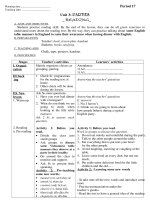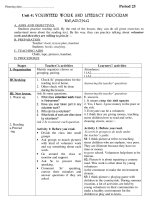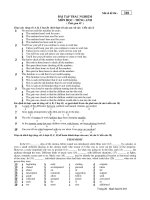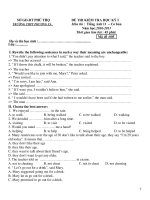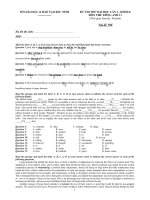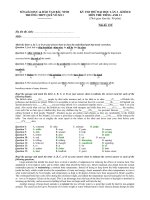Bài soạn môn học Tiếng Anh 11 - Unit 1: Friendship - Lesson: Language focus
Bạn đang xem bản rút gọn của tài liệu. Xem và tải ngay bản đầy đủ của tài liệu tại đây (159.16 KB, 5 trang )
<span class='text_page_counter'>(1)</span>Period: 6th. Date of preparation: UNIT1: Friendship Lesson: Language focus. I. OBJECTIVES: 1. Aim: By the end of this lesson, students will be able to: - Distinguish the sounds /dʒ/ and /t∫/. - Pronounce the words and sentences containing these sounds correctly. - Use some structures containing infinitives with and without to appropriately. 2. Knowledge: - Vocabulary: - Grammar/ Structures: - Pronunciation: /dʒ/ and /t∫/ 3. Skills: II. PREPARATION: 1. Teacher: textbook, workbook, chalk. 2. Students: textbooks, workbooks. III. PROCEDURE: 1. Warm-up: - T shows 2 pictures:. - T asks Ss to name the objects in the pictures. - T asks Ss to tell the differences between the sounds /dʒ/ and /t∫/ in the words. Expected answers: CHAIR & BRIDGE 2. New lesson: Teacher’s activities Students’ activities A. Pronunciation Pronouncing the two sounds - Ss listen to T and repeat. separately. - T introduces and models the two TASK 1 :. Lop11.com.
<span class='text_page_counter'>(2)</span> sounds / t∫/ and /dʒ/ / a few times and explains the differences in producing them. - T plays the tape ( or reads ) once for Ss to hear the words containing these two sounds. Then T plays the tape ( or reads) again and this time asks Ss to repeat after the tape (or T) Pronouncing the words containing the sound. - T reads the words in each column all at once - T reads the words again and asks Ss to repeat them. - T asks Ss to practice pronouncing the words in pairs. T goes around to provide help. - T asks Ss to pronounce the words and gives correction if necessary. Pronouncing sentences containing the sounds - T reads the sentences and asks Ss to underline the words with the sounds and write / t∫/ and /dʒ/ under them - T asks Ss to practice pronouncing the words in pairs. T goes around to provide help. - T asks Ss to read the sentences and gives feed back.. * Listen and repeat : / t∫/ Children mutual Changeable Cheese. / dʒ/ jam dangerous passenger joke. Practice reading aloud these sentences. 1. Just outside the village, there’s a bridge. 2. Jane always enjoys George’s joke 3. Two jeeps went over the edge of the bridge. 4. Which picture do you think the child wants to change? 5. Mix the mushrooms, chilli and cheese. 6. Do you like French salad and fish and chips?. B. Grammar A. To – Infinitive - Comment on the use of to + infinitive * Presentation: 1. the to + infinitive can be placed - Hang a poster on the board. after nouns/pronouns ( 1,2,3 ) - Ask Ss to underline the to + 2. the to + infinitive can be placed infinitive after adjectives ( 4,5,6 ). Lop11.com.
<span class='text_page_counter'>(3)</span> - Ask the Ss to comment on the use of to + infinitive in these examples. “To- inf “ is used : * to indicate the purpose : Ex: I get up early to walk. * as a modifier to replace a relative clause Ex: I have a lot of work to do ( which I have to do) * as an object of a verb Ex: I like to walk. * as an subject Ex: It is healthful to walk every morning. * in idiomatic expression : Ex: The weather is too bad for me to walk today. * Practice: Exercise 1: Put the words in the correct..... - Ask Ss to work individually. - Call on some Ss to give their answers. - Give feedback. Feedback: 1. Who wants something to eat? 2. I have some letters to write. 3. I am/was delighted to hear the news. 4. My mother has some shopping to do. 5. You always have too much to talk about. 6. It’s lovely to see you again. 7. It was/is too cold to go out. 8. I’m happy to know that you have passed..... -Copy down and underline the structure 1. My father doesn’t let me use his car. 2. Her boss made her finish the report by 5 p.m 3. He saw the cat catch a fish. 4. You had better not smoke. - Comment on the use of infinitive B. Bare infinitives ( without to ) without to * Presentation: 1. infinitive without to can be - Hang a poster on the board. placed after verbs of perceptions - Ask Ss to underline the infinitive such as feel, hear, see, watch, smell, without to notice,.... -> refer to the complete - Ask the Ss to comment on the use action. of infinitive without to in these 2. infinitive without to can be examples placed after let/make somebody; - Write the structure on the Bb had better (not)/ should.... S + Perceptive verbs + Object + Bare inf. Lop11.com.
<span class='text_page_counter'>(4)</span> - see - hear - listen to - watch - feel - smell - taste - observe , notice - had better , would rather, perceptive verbs ( see, smell, feel, watch…) * Other verbs : let make , help * Practice: Exercise 2:Rewrite these sentences..... - Ask Ss to work individually. - Call on some Ss to give their answers. - Give feedback. Feedback: 1. The police watch them get out of the car. 2. They let him write a letter to his wife. 3. I heard them talk in the next room. 4. The customs officer made him open the .... 5. The boy saw the cat jump through the.... 6. Do you think the company will make him pay 7. I felt the animal move towards me. 8. Do you think her parents will let her go.... IV. HOMEWORK ASSIGNMENT: - Pick out the inf in the following sentences and describe the function of each 1To find fault is easy. 2.It is delightful to hear the sound of the see. 3.The dog wants something to eat. 4.I saw him run the mile in four minutes. 5.Everybody wishes to enjoy life. 6.He is too ill to do any work. 7.I am not afraid to speak the truth. 8.He went to Paris to perfect his knowledge of French. - Prepare the next lesson, unit 2- reading. V. TEXTBOOK ADAPTATION: No. Lop11.com.
<span class='text_page_counter'>(5)</span> Lop11.com.
<span class='text_page_counter'>(6)</span>



